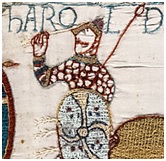|
 |
|
 |
|
|
||
The Battle of Hastings - Leadership and Strategy
The Battle of Hastings (1066)
Famous for... 1. King William Duke of Normandy (in Northern France) who won the battle (pictured right). He became William I, king of England (now known as William the Conqueror).
2. King Harold The loser but a hero:
As the last Anglo-Saxon king of England, he was fighting for the native English (or Anglo-Saxon) people who had created Europe’s richest country, economically and culturally.
3. The Bayeux Tapestry A 70 metre long embroidery, telling the story of William’s invasion and the battle. It famously shows Harold being killed by an arrow in his eye, pictured right, (although, in reality, he probably wasn’t killed in this way).
Key events in 1066 5 January The king of England (Edward the Confessor, pictured right) dies.
6 January Harold crowned king
September William gathers his invasion fleet and waits for a favourable wind at St. Valéry (on the river Somme).
20 & 25 September Harold defeats the Vikings (from Norway), near York in northern England, at the:
28 September William lands at Pevensey on the Sussex coast.
6 October Harold arrives in London and gathers his troops.
14 October The Battle of Hastings in which Harold is killed and defeated.
25 December William crowned king of England.
Why did William win?
1. William’s luck He was also known as William the Bastard (because of his illegitimate birth), so you could say he was a lucky bastard! Why? a) the Pope's blessing Pope Alexander II (pictured right) blessed William ,because Harold had broken his oath, given in Normandy in 1064 or 1065, to support William as the English king. Harold said he had been tricked. This papal blessing
b) Halley’s Comet A shooting star in April 1066 (later known as Halley’s Comet) William told his superstitious troops that this was a sign of bad luck for Harold, not them!
c) delay of invasion William's invasion fleet was delayed during September by unfavourable winds. This enabled him to land unopposed, because Harold had gone to fight the Vikings (see point 2).
2. The Battles of Fulford and Stamford Bridge (20 & 25
September) In these battles (near York in northern England), Harold crushingly defeated the invading Vikings, led
by:
This was difficult enough (Hadrada’s army was the most feared in Europe), but Harold and his exhausted troops had to march 500 miles (via London) to fight William. He also lost many of his best troops, so he had no archers at the Battle of Hastings.
3. Harold’s tactics Instead of fighting the battle, Harold should have:
But his military pride got the better of him, and he decided to attack.
4. William’s leadership Although greedy and cruel, he inspired his men through his:
a) willpower William:
b) planning He was a brilliant strategist.
c) charisma and example He led from the front (as he did at the Battle of Hastings, where he took off his helmet to show his troops he was still alive).
When and where did the battle happen?
Saturday, 14th October 1066, near the present town of Battle, near Hastings in the south of England. William had landed at Pevensey on September 28th with
Harold had at least as many men but only 3,000 professional soldiers.
How long did the battle last? 6 to 9 hours, one of the longest battles in medieval history.
What happened
The English shield wall defended the 800 yard (732 metre) Senlach Ridge between
Crucially some English troops chased after some Normans, who were pretending a retreat. This allowed William to counter-attack with his archers, foot soldiers and cavalry. William eventually won after Harold was hit (and possibly killed) by an arrow. But the English would probably have won, if they had:
William’s reign was famous for...
1. Building the Tower of London (pictured right) and lots of castles These were built to keep the English people under control. William had to defeat several rebellions including one led by Edgar, a direct descendant of
Alfred the Great (pictured right
below).
2. The Doomsday Book (1086) This was a record of everything English people owned, so they couldn’t escape paying tax!
3. The feudal system William took all the land in England, giving it to his Norman friends (Earls) who:
So the English hated their Norman landlords and William who:
|
|
|
||
|
|
||
| Copyright © wisdomtowin.com 2025 All Rights Reserved | ||
|









